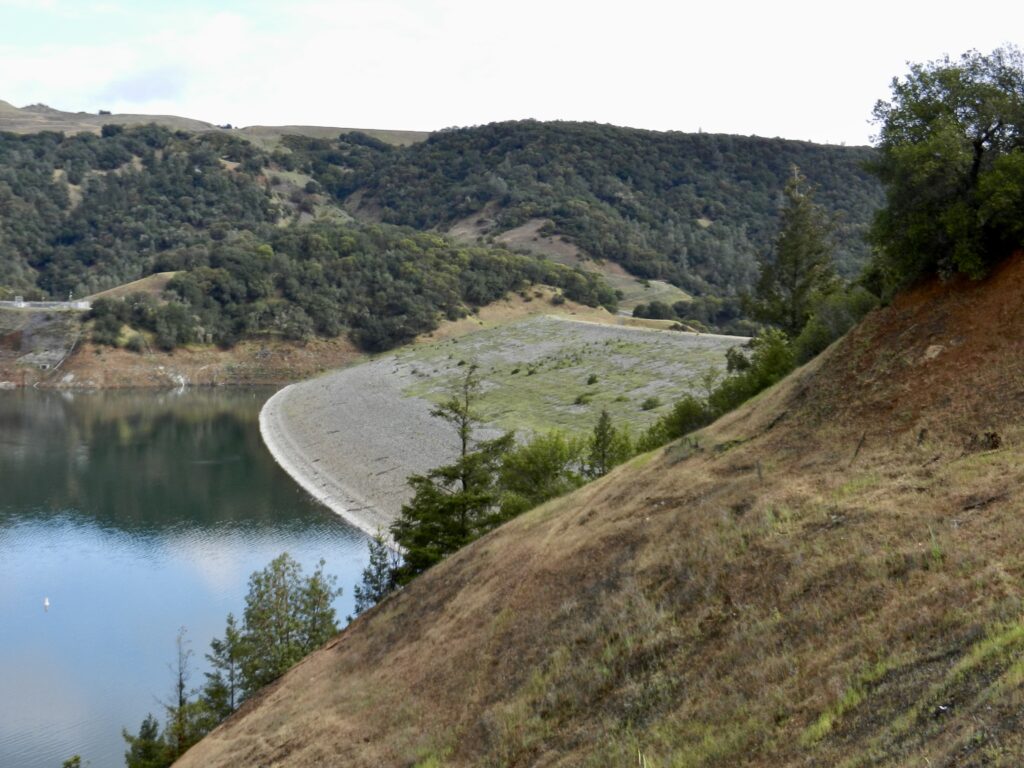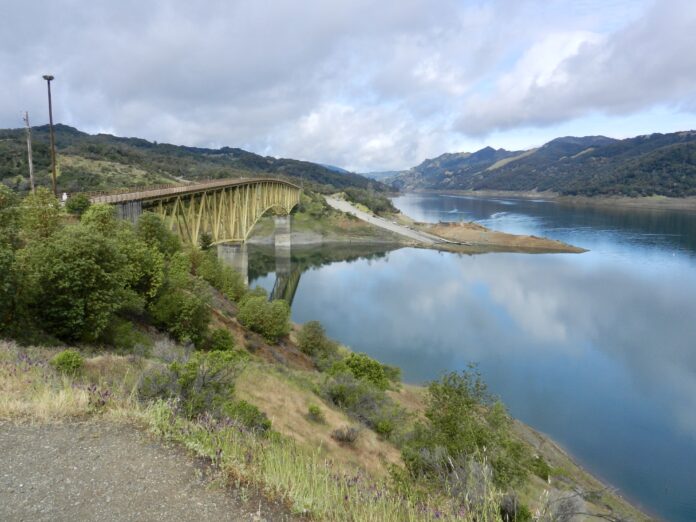The ground was wet from a light rain on a recent afternoon drive through Dry Creek Valley below Lake Sonoma. Passing the endless rows of green vineyards that cloak the valley, it appeared as though water was plentiful here.
However, this is not so. Pulling up to a look-out beside Lake Sonoma, the water sat 30 feet below the tree line, a stark marker of how parched the lake is.
Warm Springs Dam, which created Lake Sonoma in 1984, was built to control flooding in Dry Creek Valley. Today, it provides water to 600,000 residents of Sonoma and Marin County and is the largest recreational lake in the North Bay.
However, Lake Sonoma is currently only at 58% of its total capacity, the lowest April water level ever recorded.
In 2021, according to the National Oceanic and Atmospheric Association, although Sonoma County had below average rainfall and many called it the driest year on record, Lake Sonoma still sat at 62% capacity.
“This time of year, we’re [usually] seeing Lake Sonoma anywhere [around] 80 plus percent,” said Brad Sherwood, assistant general manager of Sonoma Water.
“Because of winter storms, it’s pretty full by this time of year,” Sherwood explained.
Although storms in December 2021 swelled water supplies, Sonoma County then experienced one of the hottest and driest Januarys on record. This, coupled with little rain in February and March, greatly reduced the water supply of Lake Sonoma.
The problems didn’t start this year, however. The past dry years are still affecting Lake Sonoma and Sonoma’s water supply at large.
“When we’re looking at Lake Sonoma, it is a multi-year water supply,” Santa Rosa Water Department director, Jennifer Burke, said. “We’re really looking at trying to save as much water as possible so that we can get to and through another dry year if that were to come.”
With lower water levels in Lake Sonoma and elsewhere across the Russian River Watershed beginning to strain resources, many municipalities that depend on this water are beginning to reintroduce drought restrictions. Windsor, Rohnert Park and Santa Rosa are requiring residents, businesses and public agencies to reduce water use by 20% from 2020 levels. In Marin, where some towns receive water from Lake Sonoma, the Marin Municipal Water District has mandated a 40% reduction of water use across the county.
North Bay governments aren’t the only ones implementing new constraints. This January, the state of California reintroduced water restrictions to ensure that water conservation is maintained as a high priority across the state. While these restrictions are less straightforward than local mandates, they make it clear that the drought is a great concern at the state level as well.
For many water agencies, water is usually pumped out of a reservoir and then passed to a water treatment facility, where it is filtered several times. After that, it is treated with chlorine and other chemicals to ensure it is potable. The water from Lake Sonoma is cleaned with a more natural approach.
“We’re not like your average water agency,” Sherwood said.
Take the Sonoma Water’s water-cleaning process as an example. The agency pumps water from Lake Sonoma to Dry Creek below the reservoir which then flows into the Russian River. From there, the water is filtered through the Russian River’s naturally-occurring sands and gravels, cleansing the water using the ground itself.
After this, the water is treated with chlorine, and the acidity is adjusted to ensure no bacteria or viruses have contaminated it.
Now, the agency is experimenting in order to better survive periods of drought.
“We’re seeing more droughts, more often,” Burke said. “As we continue to look at the modeling and climate change impacts, we are probably going to see more of this increase in frequency.”
This means that residents need to start using water less. These mandatory reductions are created to ensure this occurs. If a household or business were to use too much water to irrigate over a prolonged period of time, government agencies might issue citations or even shut off an offender’s water.
Luckily, according to Sherwood, Sonoma County is well prepared to conserve water, because droughts are so common in the region.
Sonoma County is “using less water than we were 20 years ago… Our community is very conservation minded,” Sherwood said. “But at the same time, you’ve got less water to squeeze out of the sponge, right?”
While residents and businesses across Sonoma should reduce their water consumption, agencies and cities are also looking to new solutions to the growing threat of climate change driven droughts.


One option Santa Rosa is considering is groundwater recharge. This involves studying parts of the city where officials could pump water into the ground for backup storage to use in hotter and drier months.
Sonoma Water is currently doing something similar in the Santa Rosa Plain. After installing a promising groundwater storage project in 2019, Sonoma Water decided to expand the project by storing water from heavy winter storms in the Santa Rosa Plain for use in the summer. This new groundwater system effectively raises the water table, making pumping from a well easier. When fully implemented, it will expand the groundwater system storage capacity. This plan is currently in its second stage, awaiting assessments that will ensure the safety of the project.
The Santa Rosa Plain Project is similar to proposed ideas by the Coho Partnership, spearheaded by Sonoma County resident and watershed expert, Brock Dolman. In addition to benefiting humans, increasing groundwater reserves is critical for fish in North Bay rivers and creeks, since many species, including coho salmon, need groundwater-fed streams in order to thrive.
However, Dolmand said, more of these alternative water source projects are needed in order to better cohabitate with native wildlife.
While these projects have proven effective, government agencies need to invest more heavily in them to meet the challenges of the day, according to Dolmand.
“We have all the solutions we need all laid out and proven—now is the time to push them out towards greater actualization at meaningful scales from ridge to river to reef,” Dolman said.
Another tool Sonoma Water hopes to use in the coming years, provided they receive the necessary grants, is called FIRO, or Forecast Improved Reservoir Operations. Using weather modeling, FIRO helps interpret when is best to pump water out of the reservoir. Effectively this system, based on scientific observations rather than antiquated bureaucratic rules, ensures more water security in a watershed.
Over eight years ago, FIRO was put in place as an experiment in Lake Mendocino (another essential water source for Sonoma County), and, according to Sherwood, the complex tool has “tremendously saved water” in Mendocino in the past two years.
As a result, Sonoma County officials plan to use FIRO in Lake Sonoma in the next two years.
While options are plentiful in regards to water security in Sonoma, it is only an ever increasing issue as the climate crisis grips the North Bay and the rest of the planet. Looking out to the damp landscape across the reflection of Lake Sonoma, a lake built originally to prevent flooding, it is clear the county is in the midst of a great shift to a drier, hotter, more severe climate.











